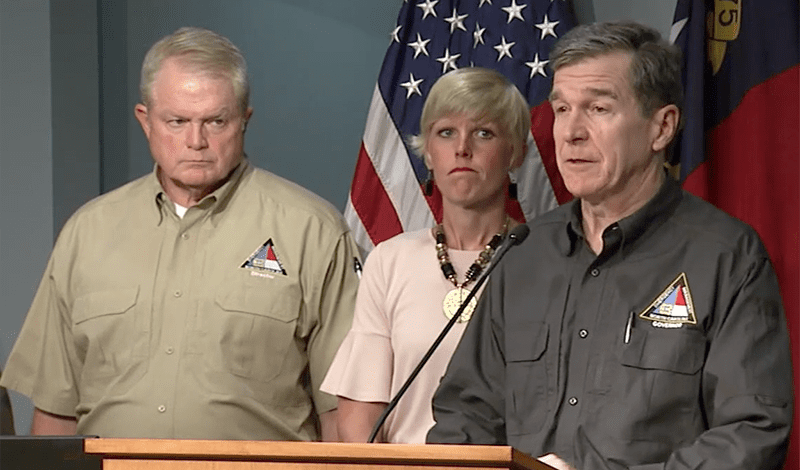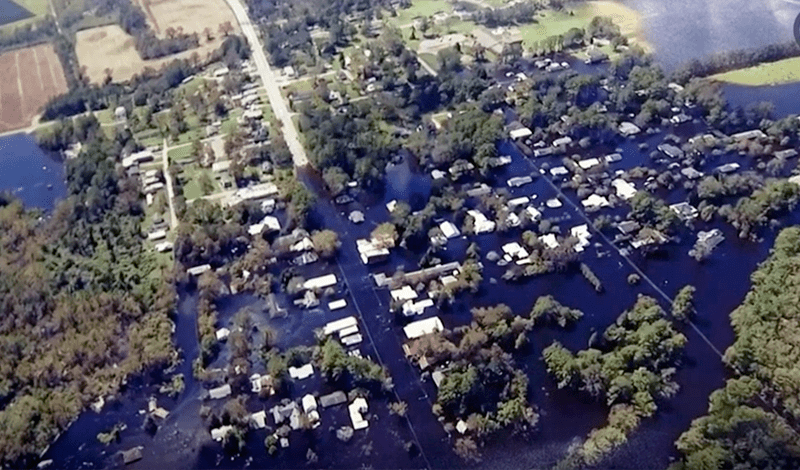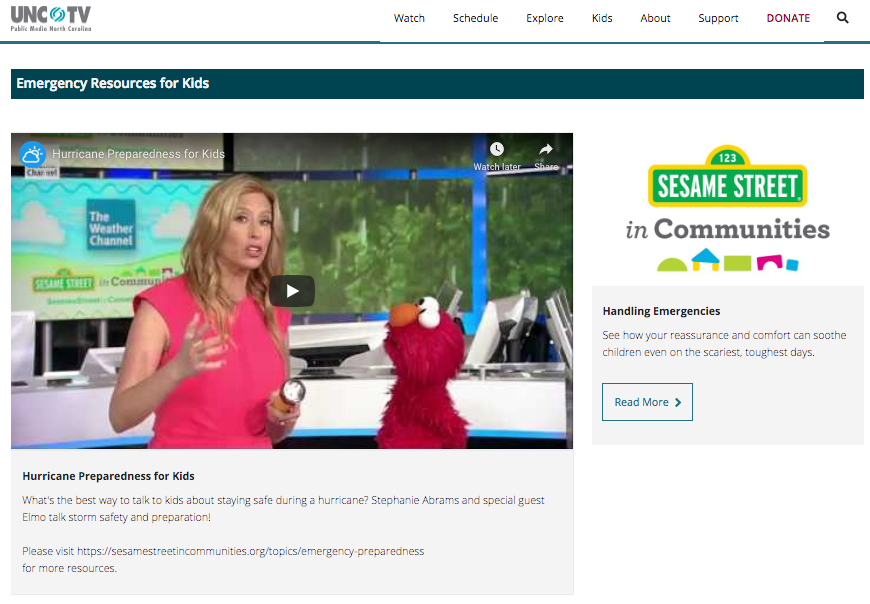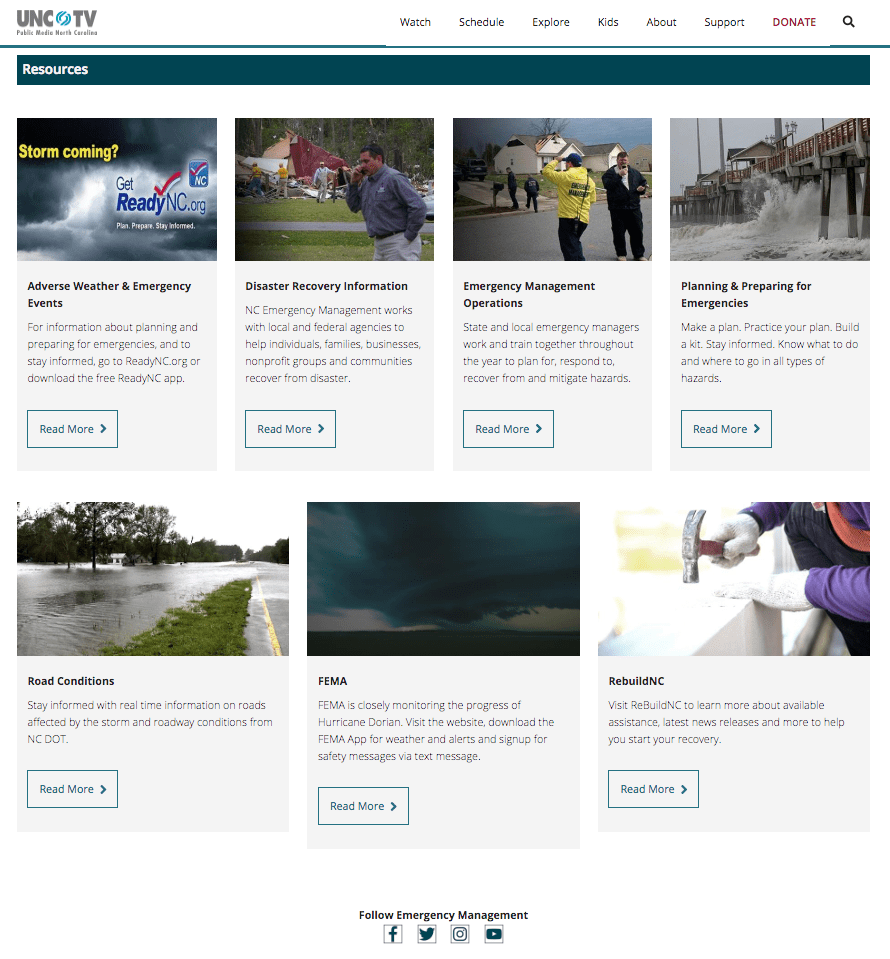
UNC-TV Keeps the State Informed During Emergency Situations

At the center of UNC-TV Public Media North Carolina’s logo is a curious medallion: two sets of parallel lines appear to spin outward from a circular center. It doesn’t take much of an imaginative leap to see its abstract resemblance to a hurricane. In fact, the design looks vaguely like the logo for North Carolina’s professional hockey team. Intentional or not, the comparison isn’t inappropriate, given how frequently hurricanes batter our coast.
But the resemblance ends there. A hurricane is a giant swirl of organized chaos. It scatters, flattens, and floods the terrain that stands in its way. UNC-TV Public Media North Carolina brings things together. On air, online, and in person, it connects North Carolinians to each other and to the world. This power to reinforce the connections that bind North Carolinians together is essential anytime our state faces a crisis situation, as we did on Labor Day week, when it became clear that Hurricane Dorian would be taking a turn toward our shores.
When Dorian hit the Bahamas, the Category 5 hurricane was one of the strongest Atlantic storms in recorded history. North Carolina braced for the worst, and the crew at UNC-TV readied itself to play its role in the state’s preparation and recovery efforts, communicating critical emergency response information and connecting affected families to resources and support networks.
Higher Expectations: Strategic Plan for the University of North Carolina, 2017-2022 identifies Economic Impact and Community Engagement as one of five central pillars in the UNC System’s mission: “Our institutions play a major role in the cultural and civic life of the state.” As a UNC System affiliate, UNC-TV maintains an unparalleled state-wide presence. Nearly every resident in all 100 counties has direct access to UNC-TV programming. On a daily basis, this programming entertains, illuminates, and informs. In a time of crisis, it saves lives.

During the Storm: Keeping NC Covered
The potential for catastrophic damage across the state grew by the hour as Hurricane Dorian slowly spiraled its way toward North Carolina. As it approached, UNC-TV shifted much of its content, production, and engineering resources to focus on emergency communications. Key technical staff worked tirelessly to ensure that the network’s broadcasts would not be interrupted by the storm’s fierce winds or flooding.
One element of the network’s crisis response strategy is to provide uninterrupted coverage of official emergency briefings. As North Carolina’s only statewide public media network, the network’s 12 stations provide all 100 counties with four full-time, unique broadcast program channels. This coverage makes UNC-TV an indispensable resource for getting vital, up-to-the-minute information about emergency services into practically every home: UNC-TV reaches 99% of NC households with televisions, 24 hours a day.
“We rely on the same technology infrastructure that broadcasts shows like Downton Abbey or NC Weekend on your TV to communicate urgent life and safety information across the state,” says Chief Executive Officer Lindsay Bierman. “It’s the ultimate return on investment.”
More than that, UNC-TV has evolved. North Carolinians have gotten more plugged in to other information sources, and the network is making the most of our changing media landscape. Its branding as “Public Media North Carolina” emphasizes the broad array of platforms the network has at its disposal. When it comes to relaying potentially life-saving information, this diversity of communications channels is invaluable.
As it became clear that Dorian was Carolina bound, UNC-TV’s North Carolina Channel Public Affairs team was deployed to the eastern and coastal regions to gather stories about those areas that would most likely be in the storm’s path. These pre-storm stories focused on emergency preparedness, storm response, information about shelters, and other resources. This content was broadly distributed on television, UNC-TV’s website, and social media platforms: facebook.com/publicmediaNC, instagram.com/publicmediaNC, and @publicmediaNC on Twitter. UNC-TV’s social media team also used Facebook and Twitter to simulcast updates from NC Emergency Management.
During the storm and, now, throughout the recovery, North Carolinians can find a trove of valuable emergency resources on UNC-TV’s webpage. These resources include links to the latest video updates and suggestions for emergency preparation, emergency assistance, and recovery assistance.
UNC-TV extends its reach even further by making its storm coverage content freely available to other media outlets. National outlets, including USA Today and The Weather Channel, tap into UNC-TV’s resources.
Thus, UNC-TV isn’t just making sure North Carolinians stay informed; it also shapes national perception of our state’s remarkable unified crisis response.

Stories that Rebuild
Typically, commercial media outlets focus their sights on a storm’s dramatic buildup and the fury that’s unleashed when the eye comes ashore. Coverage following the storm might last a day or two, capturing the destruction left behind in the storm’s wake. Catering to the public’s fascination with catastrophe, commercial coverage can sometimes verge on sensationalism.
By contrast, UNC-TV keeps its eye on storm impact long after the skies have cleared. Instead of dwelling on destruction, the network prioritizes stories about community resiliency and information that promotes recovery efforts.
“By far the biggest difference between our coverage and local news coverage is our story telling,” explained UNC-TV’s Chief Content Officer Travis Mitchell. “There are some many people, organizations and efforts that go unnoticed during the frenetic pace of 24-hour news cycles that we are presented with an opportunity to share these untold stories of hope and heroism that help us live out our mission to ‘contribute to the greater good by connecting North Carolinians to each other, the world and endless possibilities.’”
Following 2018’s Hurricane Florence, UNC-TV team members remained embedded with Governor Roy Cooper and state emergency officials as they toured damaged areas in the state. Team members also stayed in close contact with the North Carolina National Guard and other military and veterans organizations providing support to recovery efforts. After Hurricane Dorian, UNC-TV videographers once again joined the governor during his flyover of eastern parts of the state to chronicle the areas hardest hit by the storm.
The network also partners with many disaster relief organizations, including North Carolina Emergency Management, the NC Department of Public Safety, FEMA, the United Way, and the American Red Cross.
By maintaining a wide web of partnerships before and after any storm, UNC-TV is able to provide sustained coverage of recovery efforts and to keep its website content fresh with up-to-date information, putting those in need in contact with those who can help.
By capturing a storm’s impacts and showing neighbors helping neighbors, UNC-TV’s storytelling serves as a statewide platform for communicating community needs. Hurricane Florence made landfall at Wrightsville Beach on September 14, 2018. Other media outlets stopped covering the story not long afterward. But UNC-TV has stuck with New Bern for the long haul, partnering with Gatehouse Media’s New Bern Sun Journal to cover post-Florence recovery stories. Nearly a year later, it is still following the region’s recovery, even while a more recent hurricane has come and gone.
“We are committed to chronicling the long-term needs in the hardest hit communities and producing stories about the courage and resiliency of the people there,” said Travis Mitchell. “We use our platforms to raise awareness, and this provides a boost to the recovery efforts following any crisis.”


For All of North Carolina
UNC-TV’s history begins in 1955 with a single station broadcasting from Chapel Hill. Today it serves one of the largest audiences in all of public television, driven by the mission to contribute “to the greater good by connecting North Carolinians to each other, the world, and endless possibilities.” To address the changing face of North Carolina, the network is constantly innovating and expanding. Nowhere is this more apparent than in its efforts to serve children affected during a crisis situation.
A hurricane’s awesome power provokes fear in many adults; imagine the slow-burn terror younger North Carolinians must experience during a storm. Commercial media outlets that focus on the spectacle of destruction do little to ease childhood anxieties.
But UNC-TV’s strategic use of its diverse platforms gives the network room to create informative programming specifically designed to help younger viewers cope with events. Parents and children impacted by disasters can turn to Rootle, the network’s 24/7 channel dedicated to kids. There, families can find a safe space where they can discuss what may be happening or has happened to them.
UNC-TV’s Kids and Education Team has developed multi-media strategies for supporting storm safety and recovery efforts. The team curated an online repository of PBS KIDS resources, including When Something Scary Happens, Arthur: Resources on Resilience, and videos discussing emergency preparedness created by Sesame Street in Communities. The team also utilizes text messages to distribute information on emergency preparedness and how to support youth during times of disaster.
UNC-TV’s work in this arena goes well beyond programming and messaging. In the aftermath of Hurricane Florence, the team worked with Sesame Workshop to distribute over 1,000 resource toolkits to shelters. As a result of that same storm, some school districts in the east lost more than 50 days of instruction. With UNC-TV’s foresight and innovation, such prolonged disruptions to the school year might not happen again.
The technological team is preparing to harness UNC-TV’s technology infrastructure and broadcast towers to help school districts in the eastern part of the state to develop a closed circuit distance learning lab at pre-designated shelters. The goal is to prepopulate databases with PBS educational content that aligns with grade-specific school system curricula. This content could be transmitted to the local shelters on a daily basis so that dislocated students don’t fall behind in their studies.
Successful implementation of this long-term plan will also involve UNC-TV collaborating with local school systems to furnish each shelter with a storm-resistant antenna and a local wi-fi network. Once this technology is in place, UNC-TV will be able to beam educational content to the outfitted shelters, and this information could then be distributed to students using networked computer terminals.
“Given the increased frequency of hurricane related events, we think this is our greatest opportunity to be of service, by providing innovative educational solutions to school districts in impacted areas,” said Mitchell.
Eyes on the Coast
North Carolina’s September brush with Hurricane Dorian was a powerful reminder that, whenever a storm approaches, there are actually two eyes that converge on the coast: the hurricane’s and UNC-TV’s. One pummels, the other watches and informs.
To state the obvious, hurricanes can do significant damage to our state. But, by their nature, they will always weaken and move on before they disintegrate altogether. UNC-TV’s eye makes North Carolina more resilient. Unlike a hurricane, UNC-TV North Carolina Public Media is here to stay, and it’s only getting stronger.